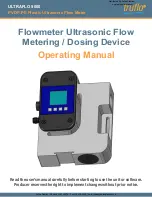
10-13
IM 253710-01E
Numerical Computations
10
Setting the equation
The combination of the measurement function and element number (Urms1, for
example) can be used as an operand to create up to four equations (F1 to F4) for
each measurement mode (normal and harmonic). There can be up to 16 operands in
one equation.
• Measurement functions for computation
Measurement functions : The measurement functions are shown in the form
of operands
(symbols used when defining equations) as follows.
• During normal measurement mode
Urms : URMS( ), Umn : UMN( ), Udc : UDC( ), Uac : UAC( ), Irms : IRMS( ),
Imn : IMN( ), Idc : IDC( ), Iac : IAC( ), P : P( ), S : S( ), Q : Q( ),
λ
: LAMBDA( ),
φ
: PHI( ), fU : FU( ), fI : FI( ), U+pk : UPPK( ), U-pk : UMPK( ), I+pk : IPPK( ),
I-pk : IMPK( ), CfU : CFU( ), CfI : CFI( ), FfU : FFU( ), FfI : FFI( ), Z : Z( ),
Rs : RS( ), Xs : XS( ), Rp : RP( ), Xp : XP( ), Pc : PC( ),
η
: ETA( ),
1/
η
: DIVETA( ),
∆
Urms : DELTAURM( ),
∆
Umn : DELTAUMN( ),
∆
Udc : DELTAUDC( ),
∆
Uac : DELTAUAC( ),
∆
Irms : DELTAIRM( ),
∆
Imn : DELTAIMN( ),
∆
Idc : DELTAIDC( ),
∆
Iac : DELTAIAC( ), Torque:
TORQUE( ), Speed: SPEED( ), Slip: SLIP( ), Sync: SYNC( ),
η
mA: MAETA( ),
η
mB: MBETA( )
• A symbol representing the element to which the measured signal is to be
applied is entered in parentheses (excluding delta functions DELTAURM( ) to
DELTAIAC( )). Elements 1, 2, 3, 4,
Σ
A, and
Σ
B are represented by the
symbols E1, E2, E3, E4, E5, and E6, respectively. One symbol from E1 to
E6 can be used, except for the following computation symbols.
• One symbol from E1 to E4 can be entered in the parentheses for FU( ) to
FFI( ) functions.
• No symbols need to be entered in the parentheses for ETA( ), DIVETA( ),
TORQUE( ), SPEED( ), SLIP( ), SYNC( ), MAETA( ), and MBETA( ).
• The element symbol inside the parentheses of delta computation
(DELTAURM( ) to DELTAIAC( )) does not represent the element to which the
measured signal is to be applied, but rather the location at which to store or
display the results of the delta computation.
∆
1,
∆
2,
∆
3, and
∆
4 are
represented by symbols E1, E2, E3, and E4, respectively. You can specify
one symbol from E1 to E4 within the definition of the delta computation. For
details regarding delta computations, see section 10.2.
• The measurement functions
η
(efficiency 1) and 1/
η
(efficiency 2) are
displayed as percentages as indicated by the equations given in Appendix 2,
“Symbols and Determination of Measurement Functions.” However,
measurement functions ETA and DIVETA described in this section are
displayed as ratios.
Example
η
: 80%, ETA = 0.8
10.3 Setting the User-Defined Function
















































